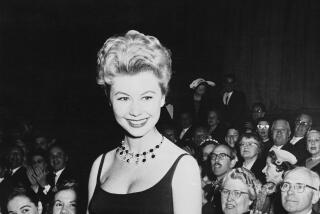âContactâ Role Is a Devil in a Blue Dress
Donât diss Neil Diamond when youâre in the room with Meg Howrey. Howrey got her start in show biz thanks to his music. At age 4, this small-town girl ran around the house in Danville, Ill., acting out âHolly Holyâ and other Diamond gems.
Howreyâs still dancing with the full-throttle glee of a child, only this time the storytelling takes place on the stage of the Ahmanson Theatre, where she appears in the Tony-winning musical âContact.â
And no, Howreyâs not the Girl in the Yellow Dress. The âSimply Irresistibleâ siren seen in TV ads, the character that made Deborah Yates an overnight sensation when âContactâ debuted on Broadway in 1999, the third actâs va-va-voom mystery woman-- that role belongs to Holly Cruikshank.
Howrey plays the Girl in the Blue Dress, listed in the credits simply as âWife.â And sheâs the undisputed star of âDid You Move?â a 30-minute tour de force that forms the second segment of âContact.â Howrey plays a browbeaten Queens housewife trying to enjoy a romantic dinner with her brutish husband (Adam Dannheisser). When her mate stalks off in search of rolls, the mousy wifeâs fantasies takes flight as she pirouettes around the restaurant with the strapping headwaiter to the soaring strains of Tchaikovsky, Bizet and Grieg.
The focus is on Howrey every moment of the performance. By the end, sheâs spent. âWhen that final curtain comes down, my entire body is sweating, Iâm crying, Iâm shaking, I almost canât get out of my chair,â says Howrey, 28, whoâs sitting in her bare-bones dressing room in the bowels of the Ahmanson. âAnd it has to be that way. Anything less would be unacceptable, for the material, to myself, to the rest of the people on stage.
âThe only time I struggled with this piece was when I approached the movement as a dance. But if I looked at everything as an actor, it all felt very natural.â
She may think of herself as an actress now, but her stork-lean legs, ramrod carriage (âMy mother always told me youâre not fully dressed unless you have good postureâ) and limpid gestures mark Howrey as someone whoâs spent years toiling at the barre.
The half-hour she spends on stage, it turns out, is the easiest to deal with. âItâs weird,â she says. âYou go through the week knowing that thereâs 30 minutes sitting there that you have to attend to. Every day. And then I do the piece and I feel proud of myself that I actually got through it, and heartbroken at the same time. And then, after I put my heart on my sleeve, and break it, I have to go back to a rented apartment in a town that I donât live in. When we started doing the show, in San Francisco, Iâd go back to my apartment feeling really unloved. I sort of had to write a Note to Self: âDonât take character home with you, go get a beer with friends after show.ââ
That Howrey should be so affected by this role speaks to her acting ability, for she has just about nothing in common with the downtrodden Wife. âAt first glance, thereâs very little me in the wife,â Howrey agrees. âI have sat across the table from people and wished I was somewhere else, so itâs kind of a matter of degrees, of understanding that part of myself and amplifying it tenfold. But no, Iâm not the kind who would stay in an abusive relationship and dream her life away.â
Hardly.
At age 3, Howrey took her first ballet lesson at a local dance school; it was love at first plie.
In her early teens, Howrey attended summer sessions at the National Academy of Art in Champaign, Ill., a boarding school for dancers run by former members of the Royal Ballet. âI was supposed to go two weeks and ended up staying 10.â She also informed her parents that sheâd be staying on for the regular school year. âI was on fire,â says Howrey. âI was just completely determined and absolutely confident it would all work out the way I wanted to.â
For years, the headstrong ballerina did, in fact, get her way. She spent one year at Walnut Hill School for Performing Arts in Boston. âI hated it,â Howrey says. âThe school was frequented by very wealthy kids who thought it would be cooler and hipper than public high school back at home. I had no tolerance for anything but the most serious attitude. In other words, I was arrogant and ridiculous,â she laughs, âbut I was also 15, so I think I was allowed to be a little jerk. I was so certain that only I understood proper serious ballet, and how could these kids who took ski vacations understand? So ... I went to New York, which,â she laughs again, âis where everyone who is arrogant goes.â
In Manhattan, Howrey moved quickly. âI called my parents. They said, âYou have to go back to school [at Walnut Hill],â and I go, âWell, no, I have an apartment. I got into Joffrey; I got a scholarship there. And I got financial aid for Professional Childrenâs School so you wonât have to pay for anything. Iâm gonna stay in New York.ââ
Fresh out of high school, in 1990, Howrey joined the Joffrey Ballet, performing in the second company and traveling with the troupeâs national touring company. She at last had her dream job. Then came the letdown. âIn my mind, Iâm going, yâknow, âIâm dancing with the Joffrey, Iâve been to Europe--thatâs about as good as it gets. Hmmm. I thought it would be a little more exciting than it is.â I couldnât figure out why I wasnât more happy.â
During a performance of âRomeo and Juliet,â Howrey had an epiphany of sorts. âI remember standing in the wings while the overture for âRomeo and Julietâ was playing, thinking to myself, âI think the words are better. I think Iâd rather say the words.ââ
When the financially struggling Joffrey downsized and moved to Chicago, Howrey stayed in New York. One day she tagged along with a friend to an acting class. This , she decided instantly, was her true calling. A few weeks later, Howrey put her pointe shoes away and began studying acting with characteristic tunnel vision.
In 1995, Howrey appeared as one of the three leads in Lincoln Center Theaterâs production of James Lapineâs â12 Dreams.â A few years later, she joined the Assembly, a collective of designers, writers, directors and actors, for whom sheâs written a play of her own.
When the call came last spring to audition for âContact,â Howrey hadnât danced in years. She hurried over to watch the Broadway production, which featured Tony Award winner Karen Ziemba as the Wife. âThereâs a simplicity about the work, but also sophistication, a great balance between respecting the audience and entertaining them,â Howrey says.
Howrey read, danced and âbabbled like an idiotâ during the âinformal chatâ with the dozen or so producers. âI was really nervous because by then I realized I might actually get this part,â she says.
Susan Stroman, who earned a Tony for âContactâsâ choreography, remembers being bowled over. âWhen Meg came to audition for me, I did not know her--and I know most of the dancers in New York,â Stroman says from her home in New York. âSo here was this woman standing in front of me, and I was watching her dance, and I couldnât believe what a strong technical ballet dancer she was. Then I thought to myself, âWell, Iâll probably get one thing or the other--either a great actress or a great dancer.â And then Meg read the scene, and she gave me goose bumps on my arms, because she has that vulnerability that you need to have the audience feel for the wife.â
âDid You Move?â relies on Howreyâs ability to remain believable as the usually meek wife, even as sheâs executing extravagantly accomplished balletic maneuvers, Stroman explains. âIf someone tells you, âDonât smile at the busboy, donât smile at the waiter, donât move,â the most rebellious thing you could do when they leave the room, the most extreme movement, would be classic ballet,â she says. âTo sort of make the joke of it work, I needed someone who had great technique, who at the same time never leaves the character of the wife. Megâs able to have the wife dance with great abandon and great joy, which is really what that storyâs about. Dance equals liberation.â
During five weeks of rehearsal in April before the âContactâ touring company hit the road, Howrey began to fully appreciate the nuances of Stromanâs choreography. âShe hears rhythms and counter-rhythms,â Howrey says, âand on the 20th listening, you go, oh my God, thereâs a trumpet there. Oh!â
But itâs the story that drives the piece for Howrey. âIâm never just doing steps--itâs a step because I see this, or that just happened, or the music is now really going nuts so everybody goes nuts. Every single thing has a reason, so thereâs never a point where Iâm left without an absolutely clear idea of why Iâm doing what Iâm doing. Thereâs a very well-made-out map on the stage, and I just follow it.â
Well, itâs a little more than a map. Thereâs also Gary Franco, who plays Wifeâs love interest. âEvery single time I see Gary, whoâs so incredibly gorgeous, and you know heâs going to whip me up in the air and make me look fantastic and give me that smile, and I run at him like a kid in a candy store--thatâs one of my favorite things.â
After the manic highs and deflating lows of her half-hour psychodrama, Howrey retires to the dressing room, pops an Advil and waits for the company curtain call that comes about an hour later.
âThe nice thing about it is, even though itâs a weird, drained emptiness that you get, I put my feet up, Gary comes by, we tell each other how good we were. Then itâs nice to have this little dancing bow at the end, so the evening ends on this upbeat feeling. Talk to me in eight months. But right now Iâm more than willing to hang out for 45 minutes.â
âContactâ at the Ahmanson Theatre, 135 N. Grand Ave., downtown Los Angeles. Tue.-Sat., 8 p.m.; Sat.-Sun., 2 p.m. Also Aug. 26 at 7:30 p.m.; Aug. 16, 30 at 2 p.m.; and Aug. 27, 8 p.m. Ends Sept. 1. $25-$75. (213) 628-2772.
More to Read
The biggest entertainment stories
Get our big stories about Hollywood, film, television, music, arts, culture and more right in your inbox as soon as they publish.
You may occasionally receive promotional content from the Los Angeles Times.










